Astronomical Clock in Prague: A Journey Through Time and Cultural Heritage
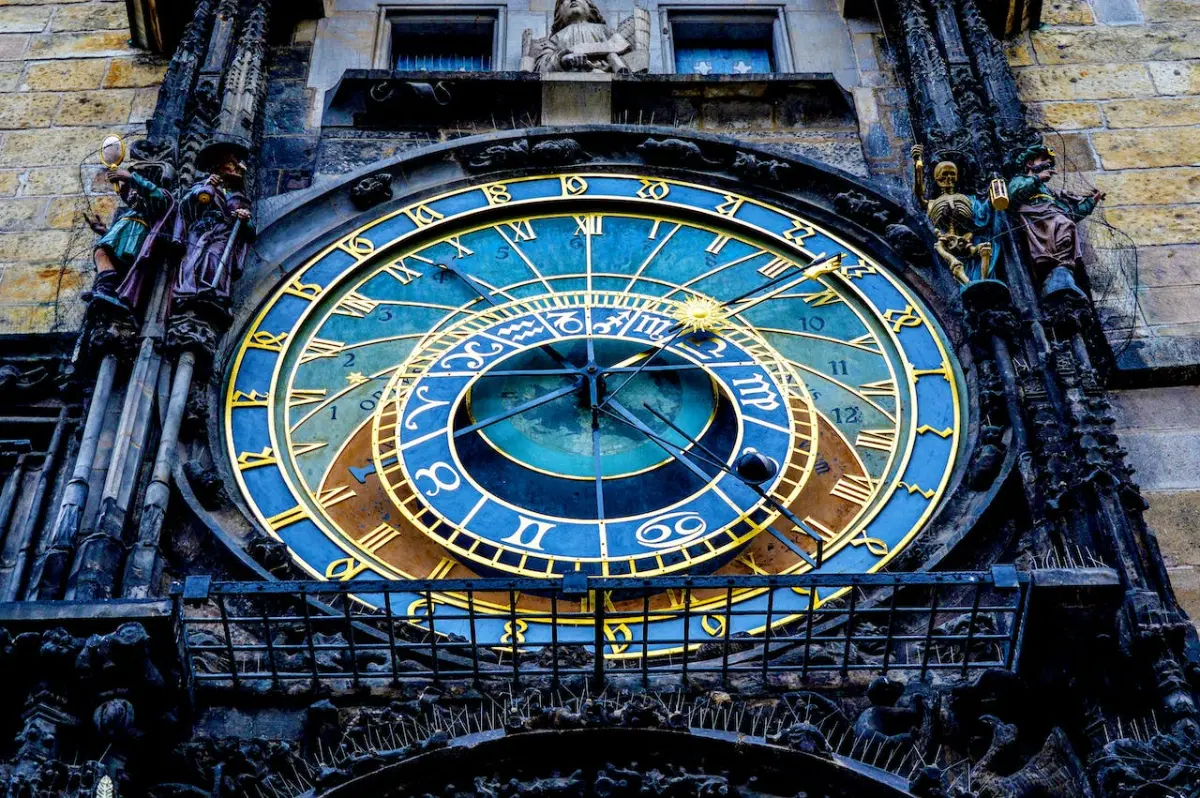
If you’re planning a visit to the Czech Republic, one of the must-see attractions is the Astronomical Clock in Prague. Located in the heart of the city’s Old Town Square, this medieval clock has been ticking since 1410, making it the third-oldest astronomical clock in the world and the oldest still in operation.
The clock not only tells time but also displays astronomical and zodiacal information. Every hour from 9:00 a.m. to 11:00 p.m., the watch comes to life as the procession of the Twelve Apostles sets in motion. This unique feature draws crowds of tourists daily, eager to witness the intricate movements of the clock’s figures.
Aside from its historical significance and impressive mechanics, the Astronomical Clock symbolizes Prague’s rich cultural heritage. It has survived wars, revolutions, and even fire, standing as a testament to the city’s resilience and enduring beauty.
Whether you’re a history buff or simply looking for a unique experience, the Astronomical Clock in Prague is a must-see attraction that will leave you in awe!
Historical Milestones of Prague’s Clock Tower
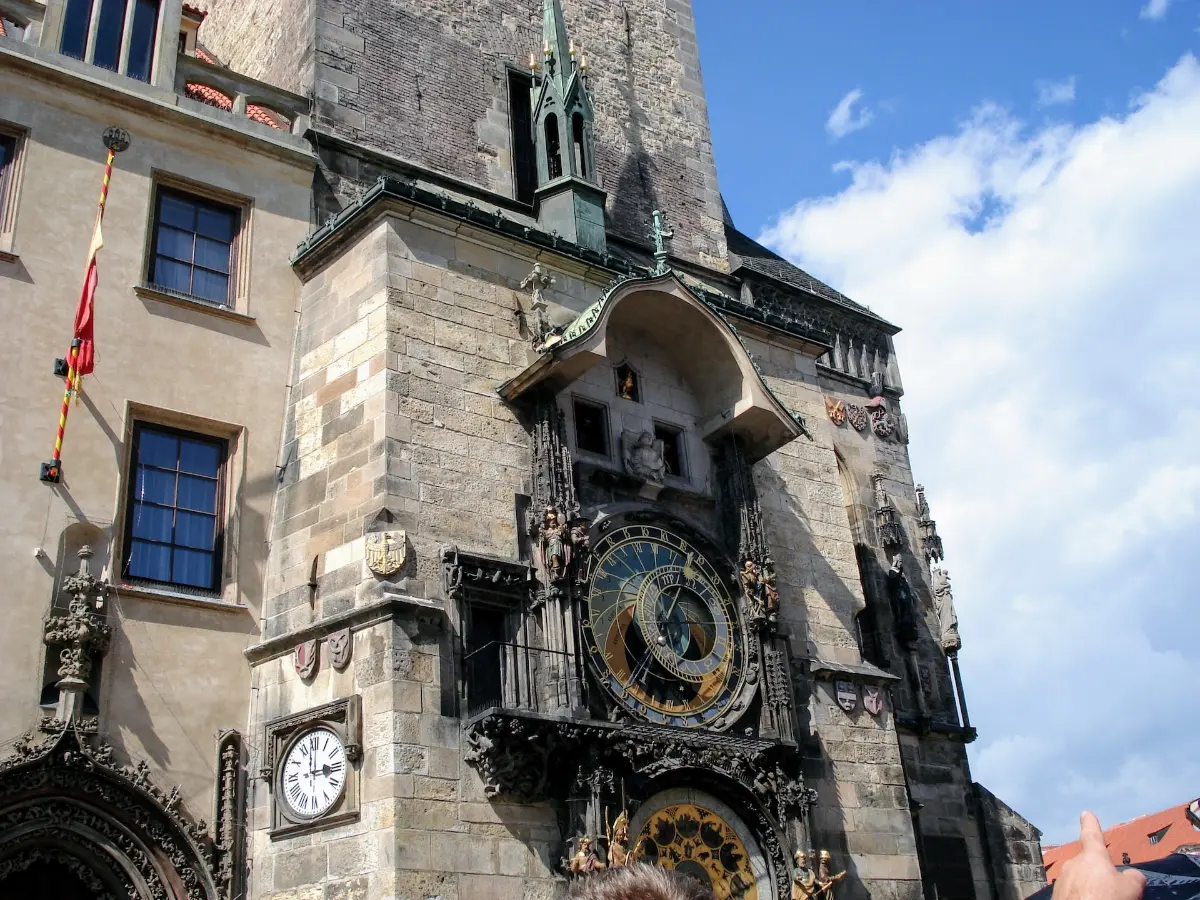
Iconic Astronomical Clock Tower in Prague’s Old Town Square, ©Kukovec / Unsplash
Medieval Mastery
The Astronomical Clock in Prague, also known as the Orloj, is a historical marvel that dates back to the medieval era. The clock was installed in the Old Town Hall in 1410, making it over 600 years old.
It was created by master clockmaker Mikuláš of Kadaň in collaboration with Jan Šindel, a professor of mathematics and astronomy at Charles University. The oldest part of the clock, the mechanical watch, and the astronomical dial were created in the same year by Mikuláš of Kadaň and Jan Šindel.
The clock tower itself is a masterpiece of Gothic architecture. It features intricate carvings and sculptures that adorn the tower’s facade. The tower’s clock face is also a work of art, with its intricate design and detailed astronomical features. The Astronomical clock is a testament to the ingenuity and skill of medieval European clockmakers.
Moments That Shaped History
Over the centuries, the Prague Astronomical Clock has witnessed many significant events in the city’s history. During the Prague Uprising in 1945, the clock tower was damaged and had to undergo extensive repair and restoration work. The clock was also injured during the 2010 floods but was quickly repaired.
In 1490, improvements were made to the clock, and Master Hanuš added a calendar plate. The plate displays the day, month, year, and position of the Sun and Moon. At midnight, the calendar plate constantly shifts to the next day.
Throughout its long history, the Prague Astronomical Clock has been a symbol of the city’s pride and ingenuity. It remains one of Prague’s most popular tourist attractions, drawing visitors worldwide to marvel at its intricate design and historical significance.
Prague Clock’s Architectural Wonders
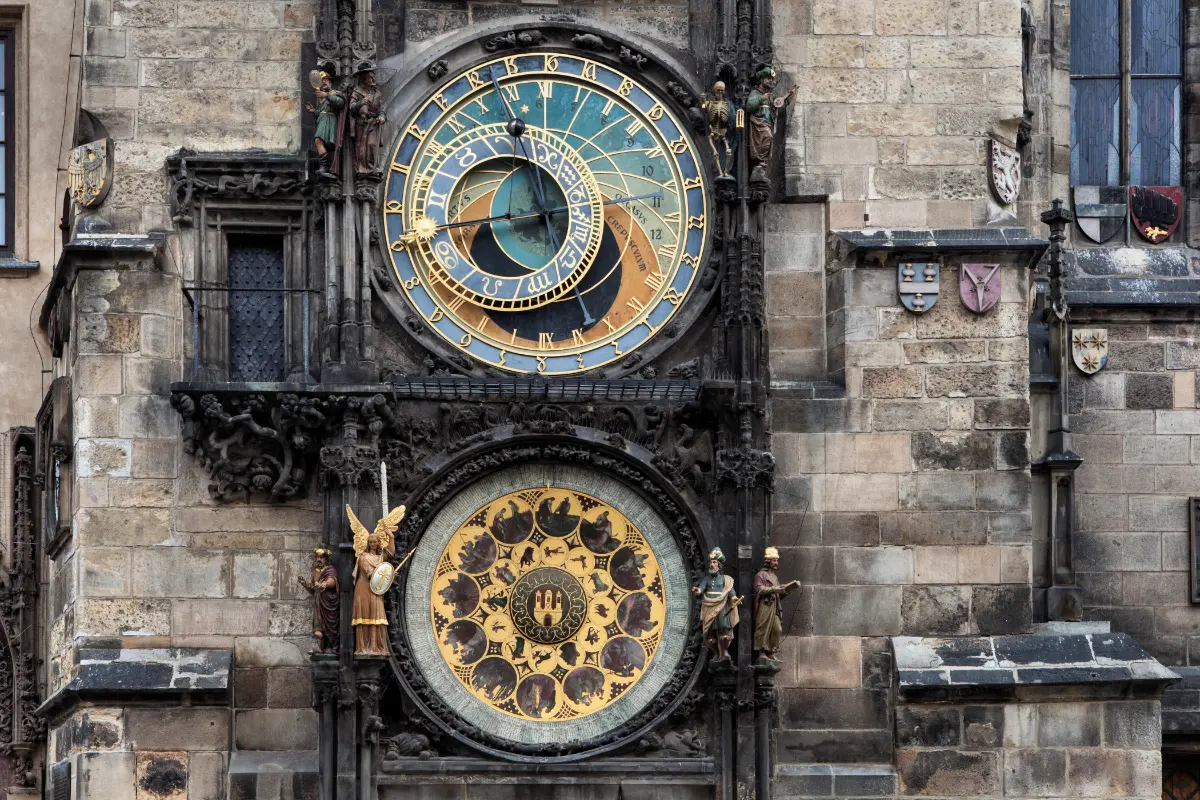
Stunning astronomical clock in Prague, ©Maciejewski / Shutterstock
The Prague Astronomical Clock is a marvel of medieval engineering and design. The clock tower is adorned with intricate Gothic statues, and the clock itself is an impressive sight to behold.
Astronomical Dial
The astronomical dial is the most prominent feature of the clock. It shows the position of the Sun and Moon in the sky, as well as the stars and zodiac signs.
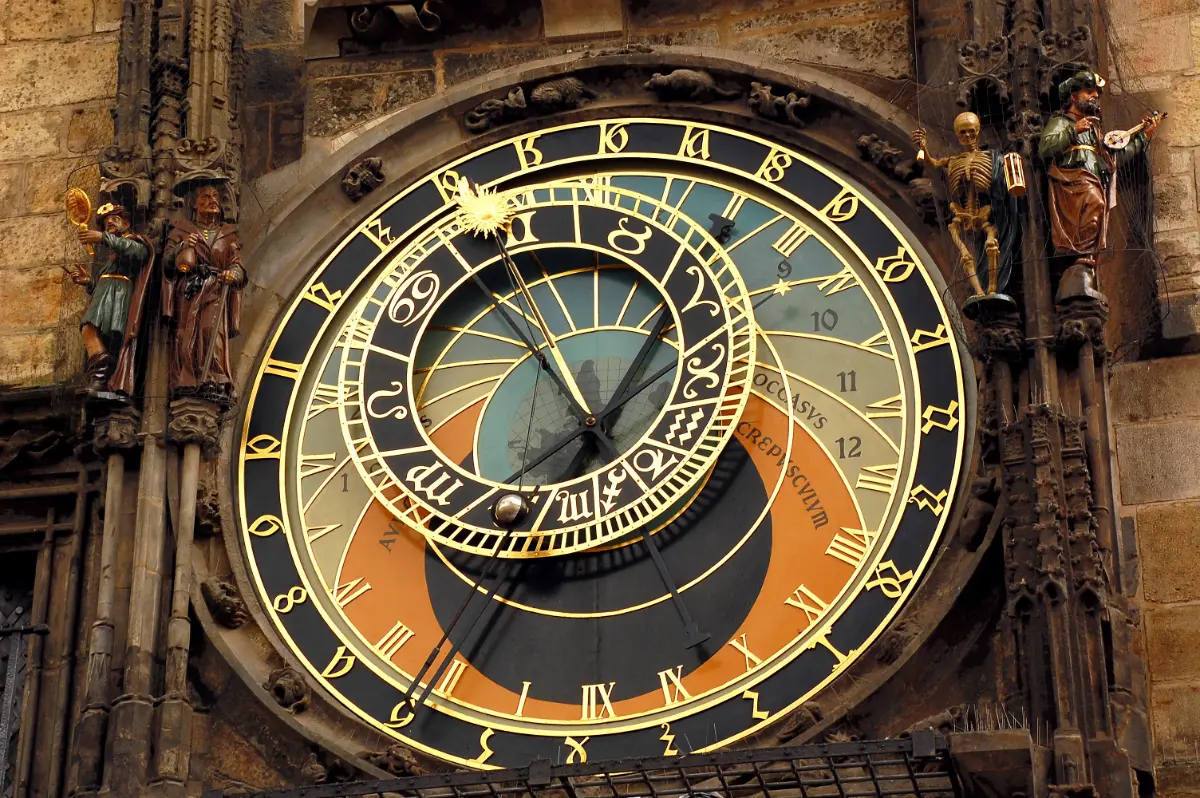
Astronomical dial displaying the Sun, Moon and zodiac signs, ©vicspacewalker / Shutterstock
The zodiacal ring is an imposing feature, with its detailed depictions of the twelve zodiac signs. The Sun and Moon are represented by golden spheres moving around the dial as the day progresses.
Calendar Dial
The calendar dial is located at the bottom of the clock face. It shows the date, month, and phase of the Moon. The dial is adorned with intricate medallions depicting the zodiac signs and various saints.
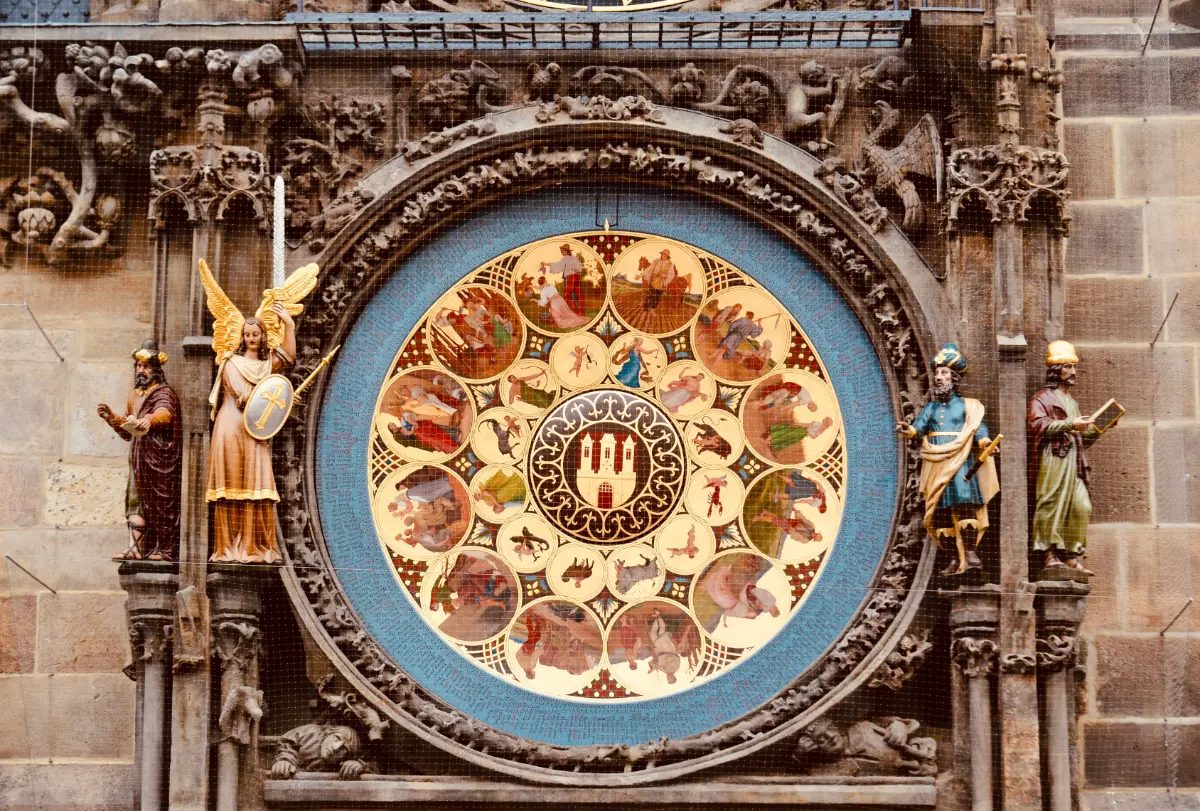
Calendar dial of Prague’s iconic astronomical clock, ©Nguyen / Shutterstock
The Astronomical Clock in Prague is a stunning example of medieval engineering and design. Its features and precise timekeeping have captivated visitors for centuries.
Symbolic Mechanics

The Astronomical Clock in Prague is adorned with intricate statues, ©Hunter / Unsplash
The Prague Astronomical Clock, or Orloj, is a fascinating machinery combining astronomical and figurative elements. Here’s a breakdown of its mechanics and symbolism:
Clock Mechanism
The clock mechanism has three main components: the astronomical dial, the statues of various Catholic saints, and “The Walk of the Apostles,” an hourly show of moving Apostle figures and other sculptures. The astronomical dial, which represents the position of the Sun and Moon in the sky, displays various astronomical details.
It is a form of the mechanical astrolabe, which was commonly used in medieval timekeeping and astronomical studies. The clock mechanism also includes a legend, an hourglass, a miser, and a chronicler.
The legend, written in Latin, tells the story of the clock’s creation and the clockmaker, Master Hanuš. The hourglass represents the passage of time, while the miser symbolizes greed. The chronicler, on the other hand, describes the importance of recording history.
Allegorical Figures
The clock also features allegorical figures representing humanity’s vices and virtues. The statistics include a skeleton representing Death and an angel, which means purity. The other figures represent the vices of vanity, greed, and lust.
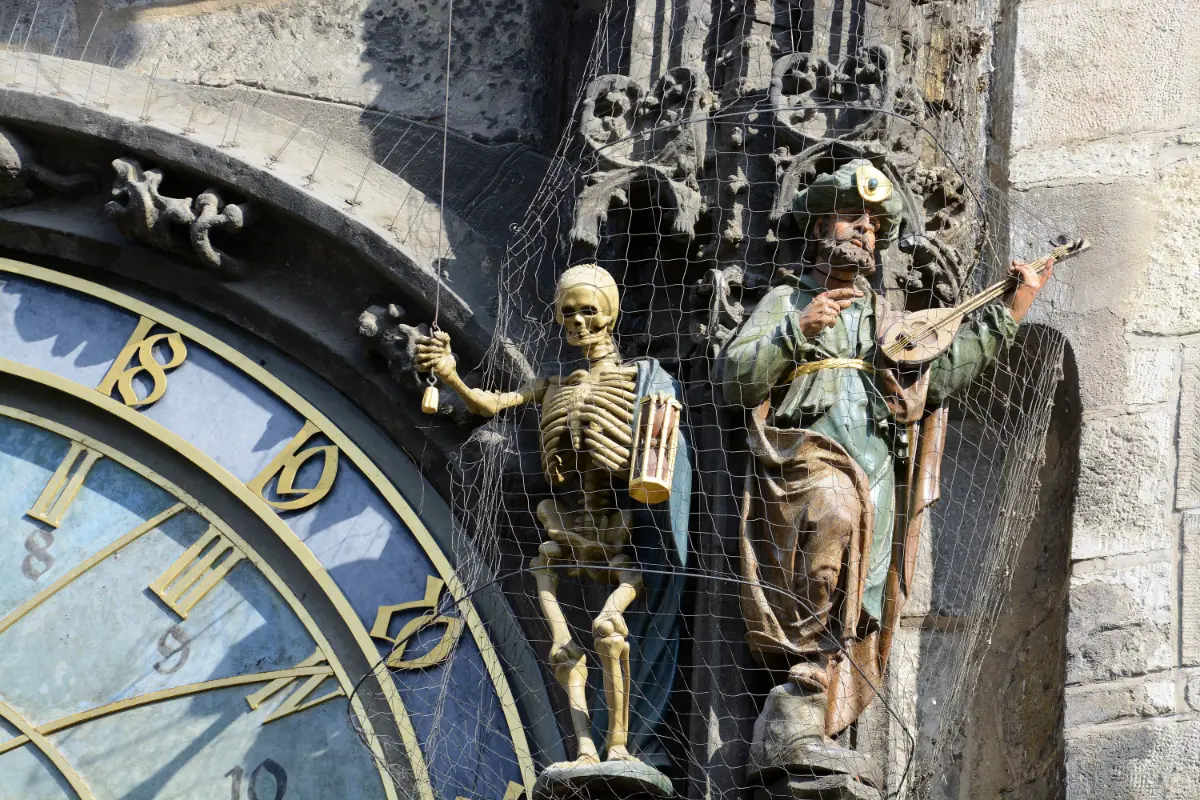
Astronomical clock in Prague featuring the skeleton and musician virtues, ©Tatiana / Shutterstock
The Walk of the Apostles is a procession of twelve apostles that appear in the windows above the astronomical dial every hour. The figures move and nod their heads while the formation of Death strikes the time.
Astronomical Functions
The Prague Astronomical Clock is a timepiece and a complex astronomical instrument that displays astronomical information. The clock has two main dials, one showing the time and the other displaying the astronomical data.
Timekeeping
The clock’s timekeeping function is accurate to within a few seconds per day. The time is displayed in Czech and Central European times, using Roman numerals to indicate the hours.
The clock also displays the position of the Sun and the Moon in the sky, as well as the sidereal time, which is based on the rotation of the Earth relative to the stars.
Astrological Aspects
The astronomical dial displays several astrological aspects, including the signs of the Zodiac and the position of the Sun, Moon, and stars.
The zodiac is divided into 12 signs, each representing a different constellation. The position of the Sun in the zodiac indicates the current season, while the part of the Moon tells the current phase of the Moon.
The clock also displays the position of the stars in the sky, with the Staroměstský Orloj showing the part of the stars relative to the horizon. The clock’s astrolabe indicates the role of the Sun and the Moon in the sky, as well as the status of the stars relative to the horizon.
Cultural Significance
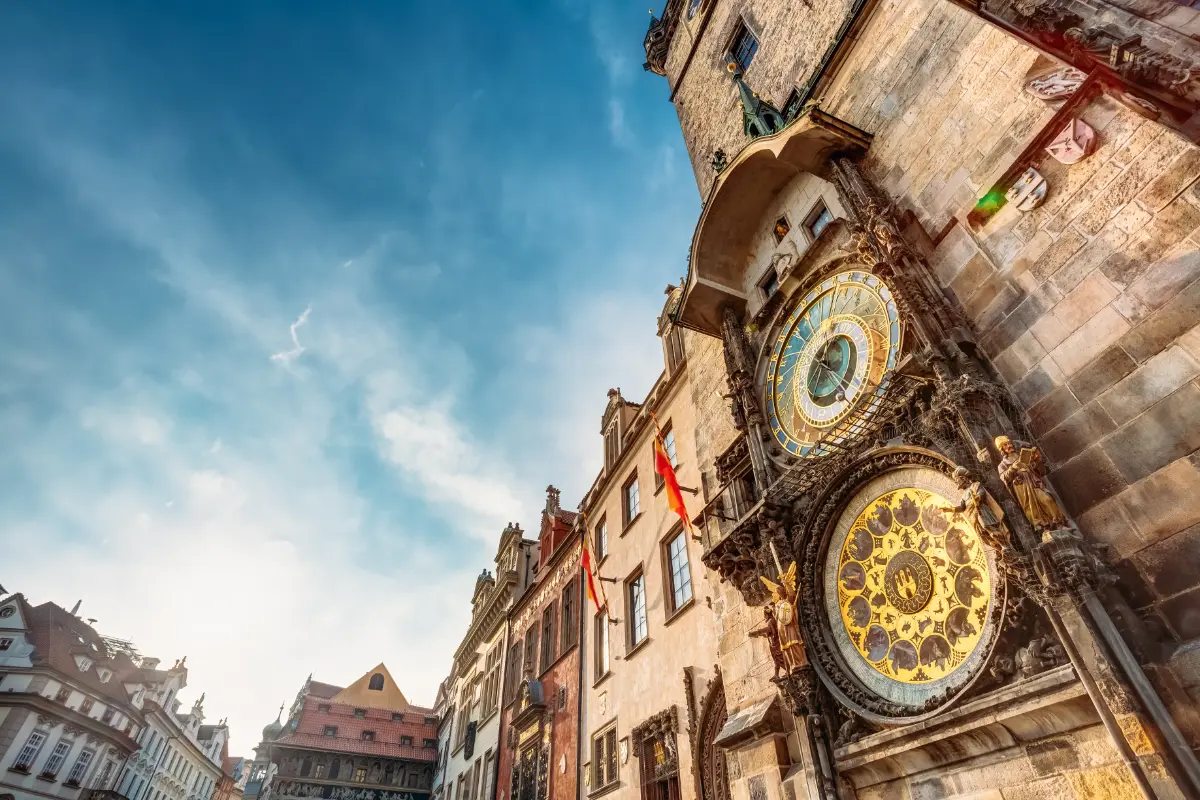
Town Hall Tower displaying the iconic Astronomical Clock, ©Trumpeter / Shutterstock
The Prague Astronomical Clock is not only a mechanical masterpiece but also has immense cultural significance for the people of Prague. It represents the city’s rich history, scientific achievements, and artistic heritage. This section will explore the legends and myths surrounding the clock and its influence and recognition in Europe.
Legends and Myths
The clock has been the subject of many legends and myths. One of the most famous legends is that of the clockmaker Hanuš, who was blinded by the city councilors after he had finished building the clock so that he could not build another one. However, Hanuš avenged by breaking the clock and making it impossible to repair for many years.
Another legend tells the story of a Turk hired to climb and fix the clock tower. The Turk, however, had other plans and tried to sabotage the clock. He was caught and executed, and his ghost is said to haunt the clock tower to this day.
Influence and Recognition
The clock has also played a significant role in European history. It measured time and astronomical details and symbolized the city’s wealth and power. Today, the clock is recognized as a masterpiece of medieval engineering and is a popular tourist attraction.
The clock has been featured in many films and TV shows, including the movie “Mission: Impossible – Ghost Protocol.” It has also been the subject of many works of art, including paintings and sculptures.
The clock is now housed in the Prague City Museum, where visitors can learn more about its history and significance. It is also used as a teaching tool at Charles University, where students can study its intricate mechanisms and learn about its cultural significance.
Visitor Information
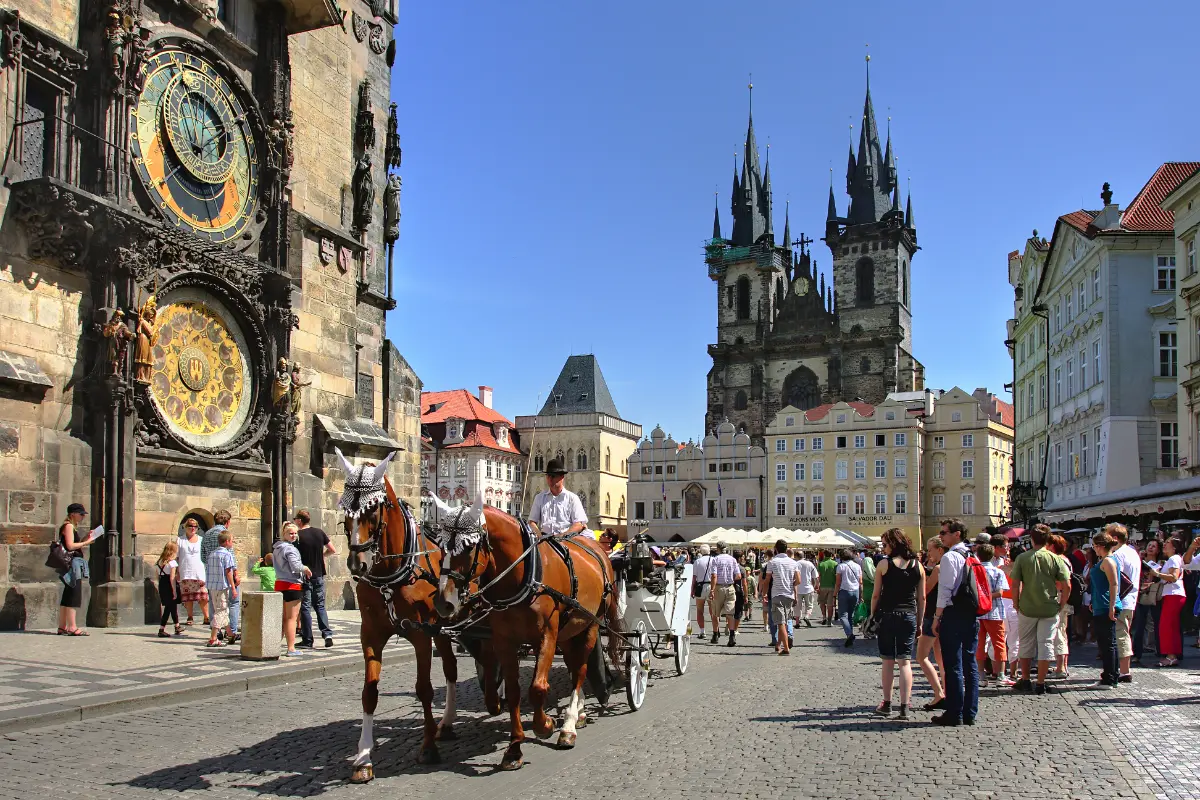
Tourist carriage at Old Town Square and the renowned Astronomical Clock, ©Glinsky/ Shutterstock
The Astronomical Clock is worth seeing if you plan to visit Prague. Here are some key details to keep in mind when planning your visit.
Clock Tower Exploration
The Astronomical Clock is located in the heart of Prague’s Old Town Square, or Staroměstské náměstí. You can easily reach the square by public transportation or by walking from nearby attractions.
Once you arrive, you can take a tour of the clock tower to see the inner workings of the clock and learn about its history. The time takes you up a narrow spiral staircase, so be prepared for some climbing.
Ongoing Exhibitions
One of the highlights of visiting the Astronomical Clock is seeing the Walk of the Apostles, a moving figure displayed every hour. The figures represent the 12 apostles and other religious figures, and each hour, they parade across the clock face to the sound of chimes and music.
In addition to the Walk of the Apostles, exhibitions and shows occur in the clock tower throughout the year. Check the schedule beforehand to see what’s happening during your visit.
Tickets and Entry Details
Visiting the Astronomical Clock is free, but there is a fee if you want to tour the clock tower. You can purchase tickets on-site or online in advance.
Remember that the building can get crowded during peak tourist season, so it’s a good idea to arrive early or book your tour in advance to avoid long lines.
Location
The Astronomical Clock is located in Old Town Square, the historical center of Prague. The square is surrounded by beautiful architecture and is a popular spot for tourists and locals alike. While in the area, check out other nearby attractions like the Charles Bridge and the Prague Castle.
The clock will impress if you’re interested in history architecture or want to see a unique mechanical marvel in action. With some planning, you can make the most of your visit and experience everything the watch offers.
Restoration and Preservation
The Prague Astronomical Clock is a masterpiece that has stood for over 600 years. Over the years, the clock has undergone several restorations and repairs to preserve its beauty and functionality.
Conservation Efforts
The clock’s most recent restoration took place in 2018 and was led by a team of experts who worked tirelessly to ensure that the watch was restored to its former glory.
The team included renowned Czech artists such as Jan Růže, Vojtěch Sucharda, and Josef Mánes, who all played a significant role in the restoration process.
During the restoration, the team discovered hidden secrets within the clock, including small stone statues of animals and a letter hidden in the hollow of the statue of St. Thomas. These objects were placed in the tower by former restorers, and their discovery added to the clock’s already rich history.
Modern Updates
In addition to the clock’s restoration, modern updates have been made to ensure the watch remains accurate and functional.
The clock’s mechanism has been updated several times, with the most recent update taking place in the 20th century by Jan Šindel. The updates have allowed the clock to keep accurate time and perform its various functions, including the hourly procession of the twelve apostles.
Despite the clock’s age, it remains a marvel of engineering and art. Its restoration and preservation efforts have ensured that it will continue to be a beloved symbol of Prague’s rich history for generations to come.
FAQs
What is the history behind the Prague Astronomical Clock?
The Prague Astronomical Clock, or the Orloj, is a medieval astronomical clock in the Old Town Square in Prague, Czech Republic.
The clock was first installed in 1410, making it one of the oldest astronomical clocks in the world. The clock tower was built in 1364, and the astronomical clock was added later.
What are the features and functions of the Prague Astronomical Clock?
The Astronomical Clock in Prague is a complex timepiece that includes an astronomical dial, a calendar dial, and a clock dial. The astronomical dial shows the position of the Sun and Moon, as well as other astronomical phenomena such as the phases of the Moon and eclipses.
The calendar dial shows the date, the zodiac signs, and the position of the Sun and Moon in the zodiac. The clock dial shows the time in both 24-hour and 12-hour formats.
Can visitors climb to the top of the Astronomical Clock in Prague, and is there a fee?
Yes, visitors can climb to the Prague Astronomical Clock Tower for a fee. The building offers a stunning view of the Old Town Square and the city of Prague. However, it is essential to note that the climb to the top of the tower involves a steep and narrow staircase.
How can one read and interpret the time on the Prague Astronomical Clock?
Reading and interpreting the time on the Prague Astronomical Clock can be challenging, as the clock uses a 24-hour format and includes astronomical information.
The time is displayed on the clock dial, divided into two circles. The outer circle shows the 24-hour time, while the inner circle shows the time in a 12-hour format. The astronomical information is displayed on the astronomical and calendar dials.
Who was the creator of the Prague Astronomical Clock?
The creator of the Prague Astronomical Clock is unknown, but it is believed that the clock was designed and built by a team of craftsmen and astronomers. The watch has undergone several renovations and repairs over the centuries, and many of its original components have been replaced.
What is the significance of the ‘Death’ figure on the Prague Astronomical Clock?
The ‘Death’ figure on the Prague Astronomical Clock is one of the clock’s most iconic features. The sculpture, located on the clock’s astronomical dial, represents the inevitability of Death. The figure moves its arm to ring a bell every hour, serving as a reminder to the people of Prague to make the most of their time.
Discover the timeless wonder of Prague’s Astronomical Clock!









